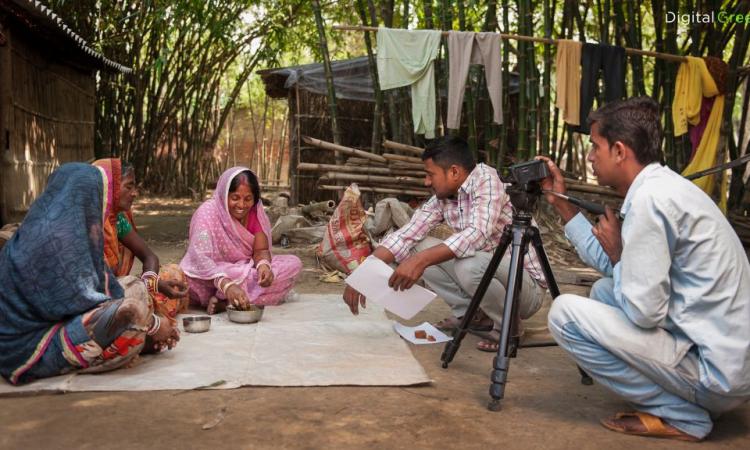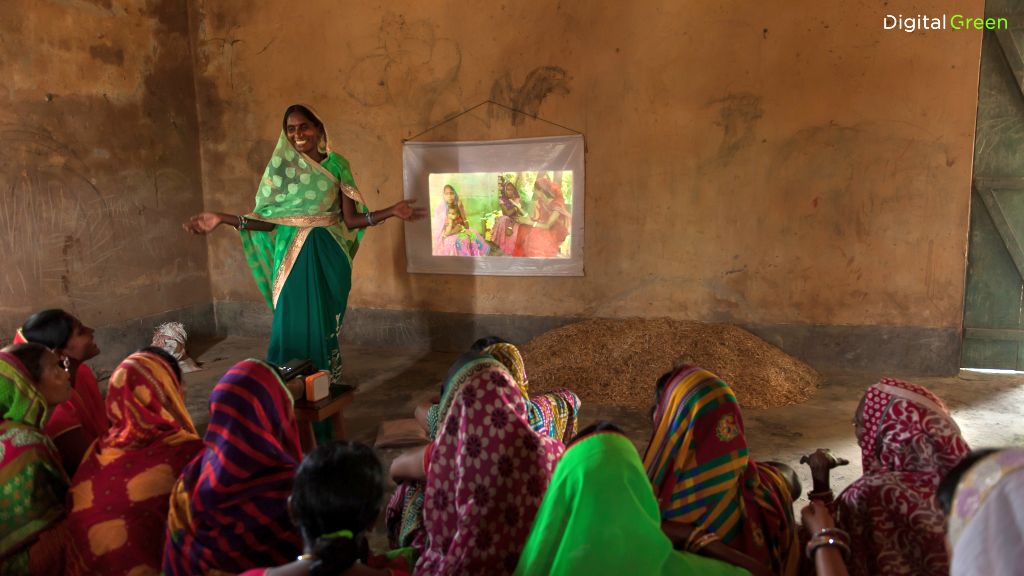
The Paudi Bhuyan tribe in Odisha are one of the most primitive and vulnerable communities in the country. They are one of India’s 75 Particularly Vulnerable Tribal Groups (PVTGs) and one of the 13 in Odisha. They live in dense forest habitats, and have low literacy rates, and are mostly cut off from technology. Agriculture is their primary source of livelihood. Even so, the support that they receive from the village-level agricultural workers is little to none. Some have never even met agricultural department staff and face an acute lack of knowledge.
Across the country, there are hundreds and thousands of these communities, smallholder farmers, and agricultural workers that work in the most remote and hard-to-reach areas, making them risk-averse. It can be challenging for these agricultural producers to gather the information that they need to not just maximize their production and profits, but also health and nutrition practices.
What if there is a proven solution in the hands of grassroots agents themselves? To share knowledge, and break out of the cycle of poverty.
Digital Green is an international development organization dedicated to leveraging the power of technology, and grassroots-level partnerships, as a means to empower farmers with training and information about agricultural, health, and nutrition practices. We have been working with government agricultural extension systems for over a decade, and since 2008, we have facilitated the production and dissemination of more than 6000 relevant videos in more than 50 different languages in over 22 countries across Asia and Africa.
The journey from introducing the approach, and training the community to produce these videos to the ownership of these community-based videos is something to note, as a carefully crafted process. These videos are produced by farmers themselves and feature local participants and agents from the rural communities themselves. This is an approach aimed at social behaviour change in these communities.
The videos dramatize best practices related to specific behaviours that the larger community can relate to, and are disseminated in the local languages and dialects. Before the production cycle, extensive contextual analysis and formative research is conducted to understand local taboos, myths, and traditional community practices that are contrary to scientifically proven best practices. The most impactful practices are identified by partnering with researchers, practitioners, and spending time in the field to understand challenges faced by the communities, and the resources that they can and cannot access.
At a dissemination stage of these videos, local volunteers, and intermediaries screen these participatory videos using low-cost, battery-operated pico projectors, and lead group discussions. Through a community-driven approach, this allows farmers to share knowledge with one another that build resilience, increase productivity, and improve their nutritional status.
Making agriculture work for nutrition: An example of our work in Odisha
Given that ‘Making Agriculture Work for Nutrition’ has been a top policy priority in India - since 2012, through a series of pilot projects in India and globally, Digital Green drew lessons from the global success of community-based videos in agricultural extension and explored the opportunity to use this solution to promote health and nutrition. Lack of knowledge and proper agricultural practices in rural communities, along with the unaffordability of nutritious food, affected the access to diverse and nutrient-dense foods, leading to poor household-level nutrition.
In the Paudi Bhuyan tribe, for example, community video-based solutions were targeted towards promoting nutrition-sensitive agriculture practices to address malnutrition among PVTGs in Deogarh district. They were particularly targeted towards children, adolescent girls, and women facing acute malnutrition by increasing their awareness about sources of nutrition, and changing their attitudes about health and safety practices as basic as handwashing.
Content and treatment of these videos would, in this case, require a more nuanced approach in order to properly assess and monitor the effectiveness of behaviour change. Unlike agricultural practices which are evident when adopted, health and nutrition practices are not always physically verifiable.
These videos, locally produced and disseminated, would identify knowledge gaps and cover topics such as inexpensive and effective agricultural practices such as crop diversification and how that adds additional sources of nutrition, and more target-specific topics such as handwashing, safe water practices, backyard vegetable gardens, special diets for pregnant and lactating women, etc. These are all logged in a calendar and are disseminated in stages so as to acquaint community members and guide them through the adoption of practices.
Over the years, we have found that featuring local community members themselves, such as SHG members, or experienced ASHA and Anganwadi Workers to demonstrate the benefits of a particular practice and sensitize the community has driven the influence of these videos. These members are called positive deviants. In fact, during contextual analysis, when local taboos and traditions are identified, some can also impact faster comprehension and adoption of these practices.

These videos also leverage and reflect existing social hierarchies, influential household relationships such as husbands, mothers-in-law, or fathers-in-law, and social cultures by featuring them in order to send a message across that could potentially lead to a better scope of adoption. This is particularly in the case for pregnant and lactating women, or children.
An example of success would be in the Mayurbanj District in Odisha where we found that community members were unaware of the different stages of infant and child feeding practices and the impact it has for the child’s growth. They also did not follow the Annaprasana ceremony which occurs when a child turns 6 months old to mark an infant’s first intake of food other than their mothers’ breast milk.
A community video on complementary feeding through a social ceremony such as Annaprasana was shared with them, and this ultimately led to the community embracing the ceremony. This ceremony is now a regular part of their social culture, and they invite health workers to do the Annaprasana when a child reaches 6 months of age.
While community videos are the fulcrum of change, there are a lot of players and factors that facilitate it. Community-level volunteers with leadership skills, such as SHG members, are trained extensively to be responsible for the production and dissemination of these videos with inputs from fellow community members.

There is also training on community mobilization, responsible use of data, and any given topics that are featured in these videos, which in the case of the Paudi Bhuyan tribe was ‘Maternal, Infant, and Young Child Nutrition (MIYCN). Digital Green plays an important role in not just the training stage but also verification and ensuring quality of these videos. Using our own Data Management System - COCO (‘Connect Online Connect Offline’), we have been able to track the adoption stages, and responsibly log data and analytics to assess the performance of these videos.
An opportunity for change
With increased digital penetration and the use of mobile phones in rural India, ICT solutions such as community videos provide opportunities to increase awareness and achieve higher adoption by targeted beneficiaries. Since the pandemic, these videos are shortened and disseminated via Whatsapp, and there have been other ICT solutions in a hybrid digital model such as IVR (Interactive Voice Response), Chatbots, and Voicebots to complement our video-based approach, and reach the ground level agents of change.
Using an innovative approach, Digital Green has assisted communities in educating themselves on practices that can improve their own health, nutrition, and agricultural production. We have consciously worked with existing health, and agricultural systems in place to ensure the ownership of our approach and expand the capacity of their interventions to impact behaviour change at a human level.
Odisha was just the beginning of mainstreaming and scaling up the Government of India’s programs to address undernutrition through a multi-social approach aimed at improving household-level food and nutrition security, feeding practices, and improving access to water, health, and sanitation.
In a digital age, for those of us with regular access to the internet and connectivity, television programs, radio, and social media offer a window of opportunity to see the world beyond and learn about our surroundings. For people living in rural areas with limited bandwidth and connectivity, community-based videos are an opportunity to learn from their neighbours and inquire about the adoption of different practices that can improve their livelihoods in order to lead a better quality of life. Governments, development agencies, and other stakeholders are critical catalysts in this learning process.
The community videos playlist is available here
Author: Oorna Mukherjee works with Digital Green as Communications Officer. Ronali Pradhan is the Regional Head - Odisha and Jharkhand at Digital Green.
/articles/community-videos-community-community